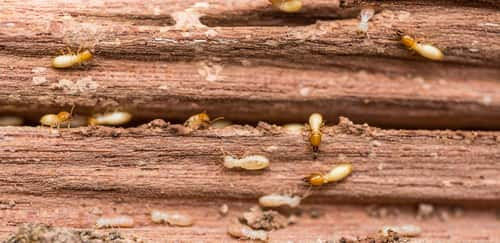How to determine if there is termite in your furniture? Check for signs of damage (such as damage to the wood or termite tunnels), and inspect the furniture’s fabric for signs of infestation (including browning, blackening, and areas of decay). Don’t let termites destroy your home!
Read on for a list of termite prevention tips to help you prevent termites from spreading.
- Keep the House Clutter-Free
- Fix Leaks
- Keep Sufficient Distance between Soil and Wood
- Keep Infested Items in the Sun
- Use Borate at the Time of Painting or Priming Wood Surfaces
- Eliminate Moisture
Wooden furniture always adds a sense of beauty and warmth to interior spaces and lasts over decades but can easily get damaged by termite infestation.
If you ever come across piles of wood dust under your wooden furniture, it is a sign of termite infestation. Once these insects invade your home and start feeding on your expensive furniture, it becomes quite difficult to get rid of termites.
Hence it is recommended to carry out regular inspections around the house to check the presence of pests and get rid of termites in house.
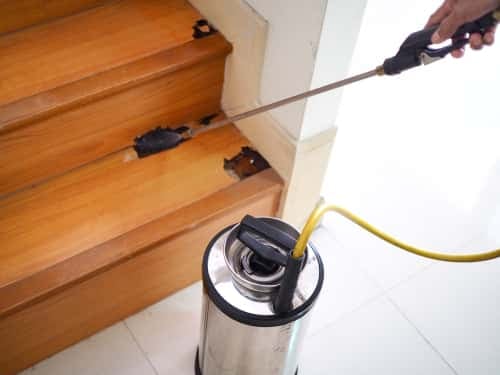
Typically, two types of termites infest wooden furniture – subterranean and drywood termites.
Subterranean termites can be found in both wood and soil. These insects prefer to live and build their colonies in moist conditions.
Subterranean termites are usually found under houses that destroy the foundations. These are also found inside dry wood walls, sidings, and eaves.
Both drywood and subterranean termites are harmful to homes. Drywood termites cause the most damage as they live inside dry furniture and walls.
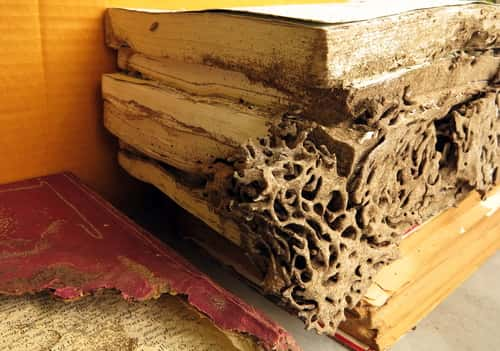
One of the major reasons why it is hard to kill termites in wood is that termites cannot be detected until they cause sizable damage to furniture or have set up large colonies. They live in colonies which makes it difficult to get rid of termites without proper tools and repelling agents.
Read this article till the very end to learn about how to effectively get rid of termites in and around your house.
Signs That Your Home Is Infested With Termite
Homes, apartments, and villas in India mostly use timber for doors and windows. Woodwork is also used for furnishing inside the house. However, the quality of wood depends on the price and purpose. Wooden products that are not treated properly for pests and insects are more prone to termite infestation. Termites are incredibly destructive and cause substantial damage within a short period. Hence pest control measures are essential for treating termites in house to keep wooden furniture and fixtures safe.
You also need to ensure that the treatment is successful in restricting further infestation.
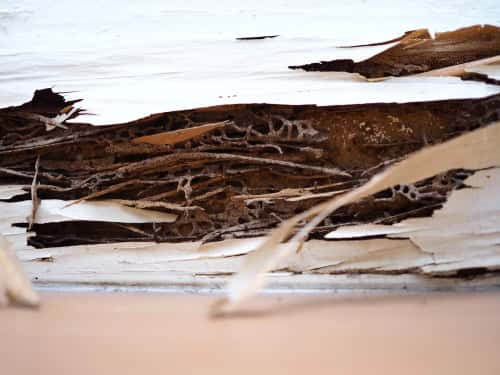
Following are some of the notable signs of termite infestation:
- Formation of mud tubes
- Signs of wood damage
- Misaligned doors and windows
- Termite swarms
- Termite mounds
Read on for a list of termite prevention tips to help you prevent termites from spreading.
Keep the House Clutter-Free
Whether you choose to hire a professional to get rid of termites or do it yourself, it is important to keep the house clutter-free. Get rid of useless paper, cardboard, newspapers, and old magazines. These provide a favorable environment for termites to thrive. If one of the rooms in the house is attacked by termites, then avoid shifting stuff and other furniture to other parts of the house.
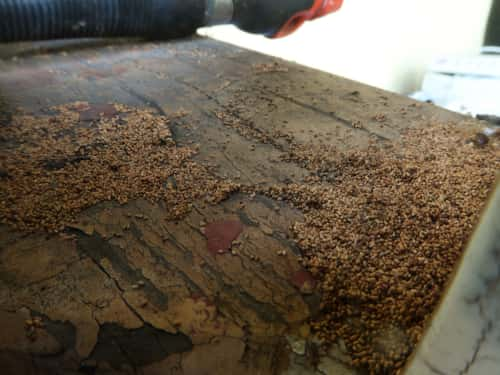
Fix Leaks
Always pay attention to any decay or leaks around the house. Moisture-laden walls and damaged roofs are perfect for termite infestation. Fix and seal leakages immediately and carry out a necessary check to prevent invasion of pests. Basements and grimy corners usually get overlooked and draw pests. Leakage in the basement is particularly damaging as it is close to the ground and easier for a termite to grow.
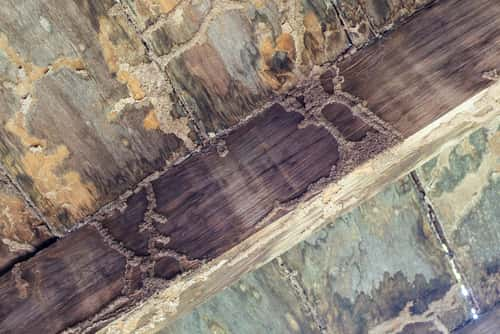
Keep Sufficient Distance between Soil and Wood
Houses with a garden should always ensure that there is sufficient distance between the wood and soil. Experts recommend keeping at least eighteen inches of distance. This effectively prevents termite attacks on doors, windows, and furniture. You can also use cement or stones to create a physical barrier between the soil and wooden structures.
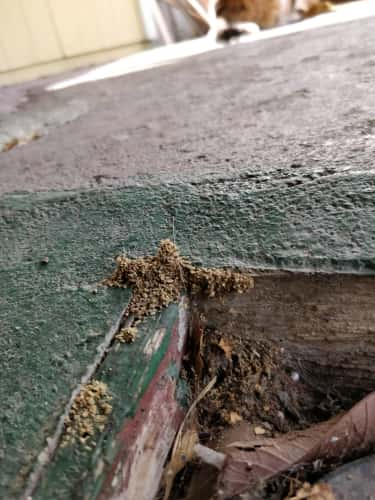
Keep Infested Items in the Sun
If you find termites in furniture, place it under direct sunlight–it is the best way to kill termites. Continue this for three consecutive days to get rid of termites.
This technique is particularly effective during the summers as the heat from the sun kills the termite and also removes excess moisture from the furniture.
Remember to dust off the furniture thoroughly and spray it with termite spray before shifting it inside. You can also follow the same practice with furniture that is not affected by termites to keep them safe.

Use Borate at the Time of Painting or Priming Wood Surfaces
Using borate is one of the best ways to get rid of termites. You can spray bare wooden surfaces with borate before priming or painting. It soaks into the wood and prevents termite infestation.
After applying the termite spray, you can use a primer or paint to protect it against moisture. The borate spray is quite strong to keep away termites for decades.
Eliminate Moisture
Moisture is one of the main reasons that attract mites and pests inside the house. Eliminating excess moisture helps in keeping termites away. If the house is in a humid environment, consider using a dehumidifier.
During the summer, you can use an air conditioner periodically to maintain a cool temperature inside the house. It also helps in removing excess moisture from indoor air.
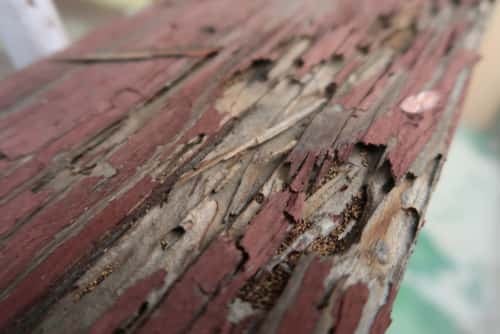
If your home is already infested with termites then it is best to seek help from professional pest control agencies. They carry out a complete inspection and then recommend appropriate termite control measures for your home. Depending on the amount of damage caused by the termites, the cost of treatment will vary. After complete home termite control treatment, you will be able to clean and maintain your furniture regularly. Apply neem oil on wooden surfaces to keep termites away. You can also book pest control services from HomeLane on an annual basis to keep the house free from pests and termites.
Wood Heat Treatment
Wood heat treatment is a highly effective method for eliminating termites from wooden furniture. It uses dry heat to raise the internal temperature of the furniture to a level lethal to termites, their eggs, and larvae. You’ll need a professional to come in for this, as it’s something you cannot do by yourself!
Here’s a breakdown of the process:
- Preparation: A qualified pest control professional will assess the furniture and identify any heat-sensitive items that need removal. They may also cover hardware or delicate finishes to protect them from the high temperatures.
- Heating Chamber: The furniture is then placed in a specially designed heating chamber. This chamber traps the heat and ensures uniform temperature distribution.
- Temperature Control: Technicians meticulously monitor and control the temperature throughout the treatment. The target temperature typically ranges between 49-60 degrees Celsius for a specific duration to ensure complete elimination.
- Post-Treatment Inspection: After the heating cycle is complete, the furniture is allowed to cool down gradually. The pest control professional will then thoroughly inspect the furniture for any signs of surviving termites.
Wood Fumigation
Wood fumigation is another effective method for eradicating termites from furniture. It involves using a powerful fumigant gas, typically sulphuryl fluoride, to penetrate the furniture and eliminate all termite life stages.
Here’s a general overview of the process:
- Preparation: Rather similar to how heat treatment is carried out, a pest control professional will first assess the furniture and remove any heat-sensitive items. However, unlike heat treatment, the furniture may not need to be enclosed in a chamber for fumigation.
- Fumigation Tent: The entire house or a designated treatment area will likely be tented with a large, sealed fumigation sheet. This ensures the fumigant gas can permeate the targeted area.
- Fumigation Process: The fumigant gas is then carefully introduced under the sheet. The house or designated area remains sealed for a specific period, allowing the gas to penetrate the furniture and eliminate termites.
- Air-out Period: After the fumigation period, the area is thoroughly aired out to remove any residual gas. The furniture can then be safely brought back inside.
A word of caution: The gas used for wood fumigation is invasive, and you will have to leave the house for up to 48 hours. Also, the chemicals used require proper handling by experienced professionals!
Conclusion
If your home is already infested with termites, it is best to seek help from professional pest control agencies. They carry out a complete inspection and then recommend appropriate termite control measures for your home.
Depending on the amount of damage caused by the termites, the cost of treatment will vary.
After completing home termite control treatment, you will be able to clean and maintain your furniture regularly. Apply neem oil on wooden surfaces to keep termites away.
You can also book pest control services from HomeLane on an annual basis to keep the house free from pests and termites.
FAQs
1. Can Kerosene Kill Termites?
Yes. Spray kerosene on surfaces infested by termites. Spray more after a few hours for the best results. Remember to be cautious if you decide to use kerosene to kill termites.
2. How to Kill Termites?
There are many methods to get rid of termites in the house. One easy DIY option is to spray the termite-infested areas with kerosene. You can also kill termites naturally by exposing them to the sun’s rays. Using peppermint oil and orange essential oils is also a great idea.
3. Can Salt Kill Termites?
Salt is often used to get rid of termites. Mix salt with hot water to make a solution and spray it on the infested areas. This will kill the termites in a couple of days.
4. Can Camphor Kill Termites?
Camphor is a common household item that can kill termites in wood. It contains sulfur that acts as a disinfectant and repels various types of pests, including termites.
5. What Is the Fastest Way to Get Rid of Termites?
Use orange and neem oils quickly and effectively kill termites. You can also expose the infested areas to direct sunlight for a few hours to kill termites.
6. Can You Get Rid of Termites by Yourself?
There are many DIY remedies available to get rid of termites in house. You can try these out. However, in case of extensive infestation, it is advisable to hire a professional pest control service.
7. What Is the Best Home Remedy to Get Rid of Termites?
Set up boric acid baits around the home or make a solution of borax powder and water and spray this solution on termite-infested areas. Placing the infested furniture in direct sunlight for some time is also a great home remedy to kill termites.
8. What Naturally Keeps Termites Away?
The smell of garlic, cinnamon, geranium, orange oil, cedarwood, and tea tree oil naturally repels termites. Applying aloe vera gel on your furniture as a protective coating also protects it against termites.
Popular Services
Modular Kitchen Designs | Home Interior Designs | Wardrobe Designs | Living Room Designs | Bathroom Designs | Space Saving Furniture | Home Office Designs | Pooja Room designs | Foyer Interior Design | Kids Bedroom Design | Interior Lighting Design |False Ceiling | Home Wallpaper | Furniture Design
Popular Locations
Modular Kitchen In Ahmedabad | Modular Kitchen In Mumbai | Wardrobe Designs In Chennai | Wardrobe Designs In Delhi| Interior Design In Mumbai | Interior Design In Delhi
Popular Blogs
Party Ideas for Holi | Assam Type House Design | Pop Designs for Bedroom | Window Grill Design | Plinth Area | MDF Vs Particle Board | Wall Colour Combinations | Vastu Shastra Colors For Living Room | Classical Interior Design | Wardrobe Dimensions | Parapet Design | How To Prevent Dust In Room | Types Of Kitchen | Wall Panel Design | Small Modular Kitchen | Pooja Room Design| HDF Wood | French Door Design | Bedroom Wardrobe | Solid Wood Vs Engineered Wood | Athangudi Tiles

